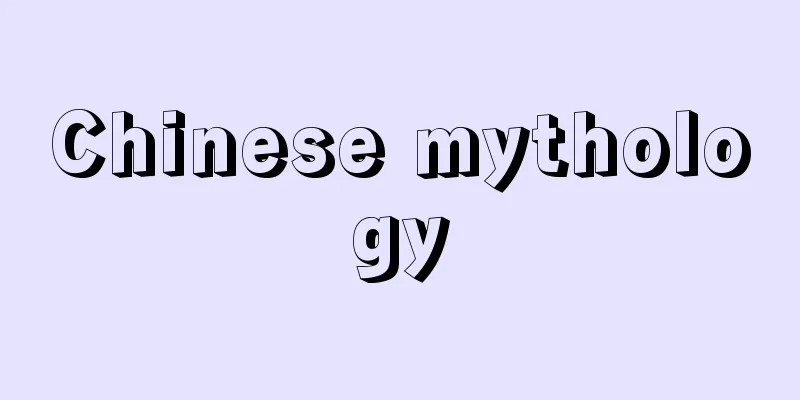Chinese mythology

|
Many of the authoritative historical texts of ancient China, including the Records of the Grand Historian, teach that from the very beginning of China, holy emperors, whom people in later generations revered as the Three Sovereigns and Five Emperors, reigned. For this reason, it has been thought that there was no mythological era in China in which gods were active, and China has tended to be considered a "country without myths." However, the absence of myths means that myths have disappeared, not that myths never existed in the first place. For example, Fuxi and Nüwa, who are counted among the Three Sovereigns and Five Emperors, were originally human-headed snake-bodied figures, and their strange appearances can still be seen in murals and other works even after the Han dynasty. This contradiction between the holy emperors who became emperors because of their virtue and their strange appearance suggests that what was originally a mythical entity was deliberately altered. China, along with India and Greece, has the honor of having developed the world's oldest civilization, but when it comes to mythology, it has not left behind a legacy comparable to those ancient civilizations. This is mainly due to the values held by intellectuals at the time regarding the recording of mythological traditions. In ancient China, the limited number of intellectuals, such as the Hundred Schools of Thought, who were able to write, were solely interested in the practical issue of governing the country. In particular, since that era was a turbulent time, the Spring and Autumn Period and the Warring States Period, governing the country was their biggest challenge. Therefore, even mythological traditions took on a sense of reality, and were adopted as facts of the past to suit their principles and beliefs, and were further transformed into moralistic historical lessons and fables that served as guidelines for life through their writings. As a result, mythological beings such as the human-headed snake body and the ox-headed human body were reborn as holy emperors who educated the people with virtue and created cultural artifacts to improve people's lives. However, it is not impossible to get a glimpse of the mythology at all, and although there is no way to know the systematic mythology, we are fortunate to be able to find fragments in a limited number of ancient documents such as the "Chu Ci", "Shan Hai Jing", "Zhuangzi", and "Huainanzi", as well as in later books such as the "Sangorekiki". Below, we will stitch together these articles to give us a glimpse of ancient Chinese mythology. In the beginning, the world was in chaos, and there was no distinction between up, down, left, and right. Eventually, clear energy rose up and became the sky, and murky energy descended and solidified to become the earth. However, originally the sky and the earth were close together, and were not far apart as they are today. Then, between the sky and the earth, a god named Pangu was born, and as he grew, the sky was pushed higher and the earth was pushed lower, and thus the heavens and the earth were created. When Pangu's life came to an end and he died, each part of his body was transformed into mountains, rivers, seas, the sun, moon, stars, and even plants and rocks. It is said that humans appeared in this world due to the work of Nüwa. Nüwa made humans from clay, but the way she made them varied in quality, which resulted in differences in ability and inability, and in complete and partial physical health. The discovery and use of fire began with a god called Sui Ren. However, since this name itself means the discoverer and founder of fire, it is more likely that it is a personification of the culture of fire rather than the name of a god. It is also said that agriculture was started by a god called Shennong. However, this name, along with Hou Ji, who is also considered the founder of agriculture, means the god of agriculture itself. In addition to these, the marriage system was started by Fuxi, and writing was started by Cangjie. Various cultures and systems were founded by the gods, and people in ancient times enjoyed rich and peaceful lives. However, a great disaster occurred in this world, and it fell into chaos. This was because the god Gonggong, who had wanted to rule this world but was unable to do so, broke one of the pillars supporting the sky in anger. Sudden fires and landslides occurred, and the world was in danger of being submerged. In another legend, it is said that the world turned into a hot hell because ten suns appeared at once, and that the chaos was caused by a sudden great flood. It is also said that the fact that the oracle bone inscriptions representing "long ago" are made of sun and flood reflects such legends about ancient great floods. These various disasters were saved by the efforts of Nüwa, Yi, Yu, and others, but the above legends are clearly myths of different lineages. Among them, Yu was chosen as the first king of Xia, the first dynasty in China, for his achievements in flood control. This Xia was later replaced by the Shang Dynasty, begun by King Tang.The mythological era came to an end around this time, and true history begins in the latter half of the Shang Dynasty. Whether all of the above were originally Han Chinese traditions or not requires further investigation. Today, various ethnic groups living in southwestern China, such as the Miao, Yao, Zhuang, and Lahu, also have myths about the creation of the world, the emergence of humankind, the occurrence of a great flood, and the emergence of multiple suns, which caused the earth to fall into chaos for a time, and the arrival of a peaceful world only after these disasters were overcome. It is not clear whether these myths were influenced by the Han Chinese, or whether they were their own original traditions, which in turn influenced the Han Chinese and were recorded in their records. Resolving this issue is one of the important issues in the study of ancient Chinese mythology. [Kiyoji Ito] [Reference items] | | | | | | Shennong | | | |Source: Shogakukan Encyclopedia Nipponica About Encyclopedia Nipponica Information | Legend |
|
『史記』をはじめとする中国古代の権威ある史書の多くは、中国にはその開闢(かいびゃく)の当初から後世の人々が三皇五帝(さんこうごてい)として敬慕する聖天子が君臨していたと説いている。そのため、中国には神々の活躍する神話時代が存在しなかったように考えられ、中国は「神話なき国」であるとされがちであった。しかし、神話がないということは神話がなくなったということであって、初めから神話が存在しなかったということではない。たとえば、三皇五帝に数えられている伏羲(ふくぎ)や女媧(じょか)は本来人頭蛇身であり、このような奇異な姿は漢代以降においても壁画そのほかにおもかげをとどめている。有徳のため帝王に就任した聖天子と、その怪異な形姿との間に認められるこの矛盾は、元来神話的存在であったものが作為的に改変されたことを示唆している。 中国は、インドやギリシアなどとともに世界最古の文明を開化させた栄誉を有しながら、こと神話に関する限り、それらの古代文明世界に比肩しうるような遺産を残していない。それは、おもに神話伝承の記録化に対する当時の知識人たちの価値観のありようによっている。古代中国では、文筆をとることのできた諸子百家などの限られた数の知識層の関心は、もっぱら治国という現実問題に向けられていた。またとくにその時代が春秋戦国期という激動の時代にあたっていたため、彼らにとっては治世こそが最大の課題であった。したがって、神話伝承すらも現実性を帯び、彼らの主義・主張に都合のよいように過去の事実として採用され、さらに彼らの文筆によって道徳臭の濃い歴史上の教訓や、人生の指針となる寓話(ぐうわ)につくりかえられた。そのため、人頭蛇身や牛頭人身などの神話上の存在が徳をもって人民を教化したり、文物を創始して人々の生活を向上させた聖天子に面目を改められたのであった。 しかし、神話のおもかげをまったくうかがい知ることができないわけではなく、体系的な神話を知るすべもないにしろ、幸いに『楚辞(そじ)』『山海経(せんがいきょう)』『荘子(そうじ)』『淮南子(えなんじ)』などの限られた一部の古文献や、『三五歴記(さんごれきき)』などの後世の書のなかにその断片を認めることができる。以下にそれらの記事を縫合して中国古代神話の一端をうかがうことにする。 世界は初め混沌(こんとん)とし、上下左右の区別もつかなかった。やがて清らかな気が上昇して天となり、濁った気が下りて凝固し、地となった。しかし、当初天と地は接近しており、今日みるように遠く離れてはいなかった。そしてこの天地の間に盤古(ばんこ)という神が生じ、その成長につれて天はより上に、地はより下へと押されていき、ここに天地が開闢した。やがて盤古の寿命が尽きて死ぬと、その身体の各部分が山岳や河川、海、日月、星辰(せいしん)、さらに草木や岩石などに変化した。 この世界に人間が出現したのは、女媧の営為によると伝えられている。女媧は泥土をこねて人間をつくったが、そのつくり方に精疎の差があったため、それが有能・無能や身体の全・不全などの違いとなったという。火の発見とその利用は燧人(すいじん)という神に始まる。ただしこの呼び名自体が火の発見者、創始者を意味するから、神名というよりむしろ火の文化の擬人化である可能性が濃い。また農耕は神農(しんのう)という神によって始められたという。ただしこの名も、同じく農耕の創始神とされている后稷(こうしょく)とともに、農業の神そのものを意味している。これらのほか、婚姻の制は伏羲(ふくぎ)、文字は蒼頡(そうきつ)によって始められるなど、さまざまな文化や制度が神々によって創始され、太古の人々は豊かで平和な生活を享受していた。 ところが、この世界に大きな災害が発生し、大混乱となった。それは、この世界の支配を望んで果たせなかった共工(きょうこう)神が、立腹のあまり天を支えている柱の1本を折ったためである。突然火災や地崩れが生じ、この世界は水没の危険にさらされた。別の伝承では、10個の太陽が一度に出現したためにこの世が赫熱(かくねつ)地獄に化したともいい、また大混乱は突然の大洪水の発生によったとも伝えられている。なお「昔」を表す甲骨文字が日と大水からできあがっているのは、太古の大洪水に関するこのような伝承を反映しているものともいわれている。そしてこれらのさまざまな災禍は、女媧、羿(げい)、禹(う)らの活躍によって救われるが、以上の諸伝承は明らかに系統の異なる神話であったと思われる。なかでも禹は、治水の功によって中国最初の王朝といわれる夏(か)の初代の王に推戴(すいたい)された。のちにこの夏にかわったのが湯(とう)王に始まる殷(いん)王朝で、神話時代はこのころ終わりを告げ、真の歴史がこの殷王朝の後半から始まる。 以上はそのすべてが漢民族本来の伝承であったかどうか、なお検討を要する。今日、中国西南地区に住むさまざまな民族、たとえばミャオ(苗)、ヤオ(瑤)、チュワン(壮)あるいはラフ(拉祜)族などの諸族の間にも同じように天地創始や、人類出現後、大洪水の発生、複数の太陽の出現という災害によって地上が一時期混乱に陥り、それを克服したあとに初めて平安な世界が訪れたという内容の神話が語り伝えられている。これらは漢族の影響を受けたものであるのか、それとも彼ら本来の伝承であって、それが逆に漢族に影響を与えてその記録にとどめられるようになったのか、つまびらかではない。この解決は、中国古代神話の研究上、重要課題の一つである。 [伊藤清司] [参照項目] | | | | | | | | | |出典 小学館 日本大百科全書(ニッポニカ)日本大百科全書(ニッポニカ)について 情報 | 凡例 |
>>: Chinese People's Political Consultative Conference
Recommend
Aesthetic consciousness (English spelling)
Consciousness is the function of the mental attit...
Apollo - Apollon (English spelling) Apollōn
In Greek mythology, he is the god of light, medic...
Hatsushima
An island in Sagami Bay, the easternmost part of S...
Endothermic reaction - Endothermic reaction
A chemical reaction is a reaction that absorbs he...
Reiwa Shuuge - Ryo no Shuuge
This is a compilation of commentaries on the Yoro...
Oriental particolored bat
A general term for mammals in the family Vespertil...
Takegaeshi - Takegaeshi
A traditional children's game. A handful of s...
Tragopan caboti (English spelling)
…[Ryozo Kakizawa]. … *Some of the terminology tha...
Saruyacho meeting place
The Edo Shogunate established this office to lend ...
Ptolemaios Keraunos (English spelling) Ptolemaios Keraunos
…He was pursued by the combined forces of Pyrrhus...
Ring opening polymerization
This is a reaction in which both the ring-opening...
Omoto - Taihon
〘Noun〙 (also "daihon") The fundamental t...
Poulenc - Francis Poulenc
French composer. Born in Paris. He began piano le...
Subject - Kamoku
〘noun〙① A division of something into several categ...
ell
…Here we can see a typical example of the idea of...






![Severn [river] - Severn](/upload/images/67cc062ed7914.webp)


